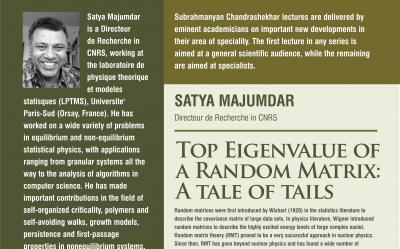Random matrices were first introduced by Wishart (1928) in the statistics literature to describe the covariance matrix of large data sets. In physics literature, Wigner introduced random matrices to describe the highly excited energy levels of large complex nuclei. Random matrix theory (RMT) proved to be a very successful approach in nuclear physics. Since then, RMT has gone beyond nuclear physics and has found a wide number of applications in various fields in physics, mathematics, biology and statistics. These include quantum chaos, disordered systems, string theory, number theory just to name a few. The real beauty of RMT is in providing bridges between seemingly different areas of science.
Recently there has been a renewed interest in RMT concerning the extreme statistics, i.e., the statistical properties of the top (largest) eigenvalue of a random matrix. The celebrated Tracy-Widom limiting law has been found in a large number of unexpected domains and has recently been measured experimentally. In these lectures I will discuss some of the recent developments with a particular focus on the large deviation tails of the top eigenvalue. We will see how the Coulomb gas method of statistical physics can be successfully used to understand very simply such rare events. In addition, we will see how there is a hidden third order phase transition in this system. Similar third order phase transitions were earlier observed in completely different contexts, namely in the two-dimensional Yang-Mills gauge theory. I will also discuss how this Coulomb gas method can be successfully used in other problems ranging from quantum entanglement in bipartite systems to the celebrated vicious walker problem introduced by de Gennes and Fisher.


